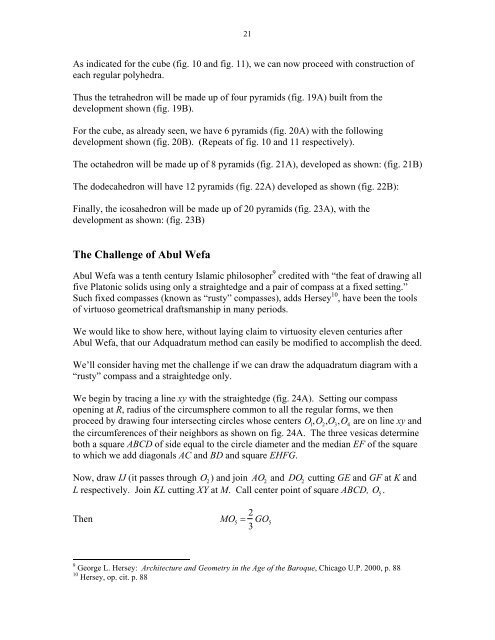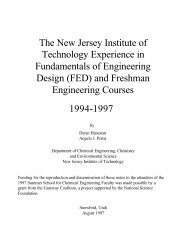Ad Quadratum Construction and Study of the Regular Polyhedra
Ad Quadratum Construction and Study of the Regular Polyhedra
Ad Quadratum Construction and Study of the Regular Polyhedra
You also want an ePaper? Increase the reach of your titles
YUMPU automatically turns print PDFs into web optimized ePapers that Google loves.
21<br />
As indicated for <strong>the</strong> cube (fig. 10 <strong>and</strong> fig. 11), we can now proceed with construction <strong>of</strong><br />
each regular polyhedra.<br />
Thus <strong>the</strong> tetrahedron will be made up <strong>of</strong> four pyramids (fig. 19A) built from <strong>the</strong><br />
development shown (fig. 19B).<br />
For <strong>the</strong> cube, as already seen, we have 6 pyramids (fig. 20A) with <strong>the</strong> following<br />
development shown (fig. 20B). (Repeats <strong>of</strong> fig. 10 <strong>and</strong> 11 respectively).<br />
The octahedron will be made up <strong>of</strong> 8 pyramids (fig. 21A), developed as shown: (fig. 21B)<br />
The dodecahedron will have 12 pyramids (fig. 22A) developed as shown (fig. 22B):<br />
Finally, <strong>the</strong> icosahedron will be made up <strong>of</strong> 20 pyramids (fig. 23A), with <strong>the</strong><br />
development as shown: (fig. 23B)<br />
The Challenge <strong>of</strong> Abul Wefa<br />
Abul Wefa was a tenth century Islamic philosopher 9 credited with “<strong>the</strong> feat <strong>of</strong> drawing all<br />
five Platonic solids using only a straightedge <strong>and</strong> a pair <strong>of</strong> compass at a fixed setting.”<br />
Such fixed compasses (known as “rusty” compasses), adds Hersey 10 , have been <strong>the</strong> tools<br />
<strong>of</strong> virtuoso geometrical draftsmanship in many periods.<br />
We would like to show here, without laying claim to virtuosity eleven centuries after<br />
Abul Wefa, that our <strong>Ad</strong>quadratum method can easily be modified to accomplish <strong>the</strong> deed.<br />
We’ll consider having met <strong>the</strong> challenge if we can draw <strong>the</strong> adquadratum diagram with a<br />
“rusty” compass <strong>and</strong> a straightedge only.<br />
We begin by tracing a line xy with <strong>the</strong> straightedge (fig. 24A). Setting our compass<br />
opening at R, radius <strong>of</strong> <strong>the</strong> circumsphere common to all <strong>the</strong> regular forms, we <strong>the</strong>n<br />
proceed by drawing four intersecting circles whose centers O 1 are on line xy <strong>and</strong><br />
<strong>the</strong> circumferences <strong>of</strong> <strong>the</strong>ir neighbors as shown on fig. 24A. The three vesicas determine<br />
both a square ABCD <strong>of</strong> side equal to <strong>the</strong> circle diameter <strong>and</strong> <strong>the</strong> median EF <strong>of</strong> <strong>the</strong> square<br />
to which we add diagonals AC <strong>and</strong> BD <strong>and</strong> square EHFG.<br />
,O2 ,O3 ,O4 Now, draw IJ (it passes through O 2) <strong>and</strong> join AO2 <strong>and</strong> DO2 cutting GE <strong>and</strong> GF at K <strong>and</strong><br />
L respectively. Join KL cutting XY at M. Call center point <strong>of</strong> square ABCD, .<br />
Then MO 5 2<br />
3 GO 5<br />
9 George L. Hersey: Architecture <strong>and</strong> Geometry in <strong>the</strong> Age <strong>of</strong> <strong>the</strong> Baroque, Chicago U.P. 2000, p. 88<br />
10 Hersey, op. cit. p. 88<br />
O 5




